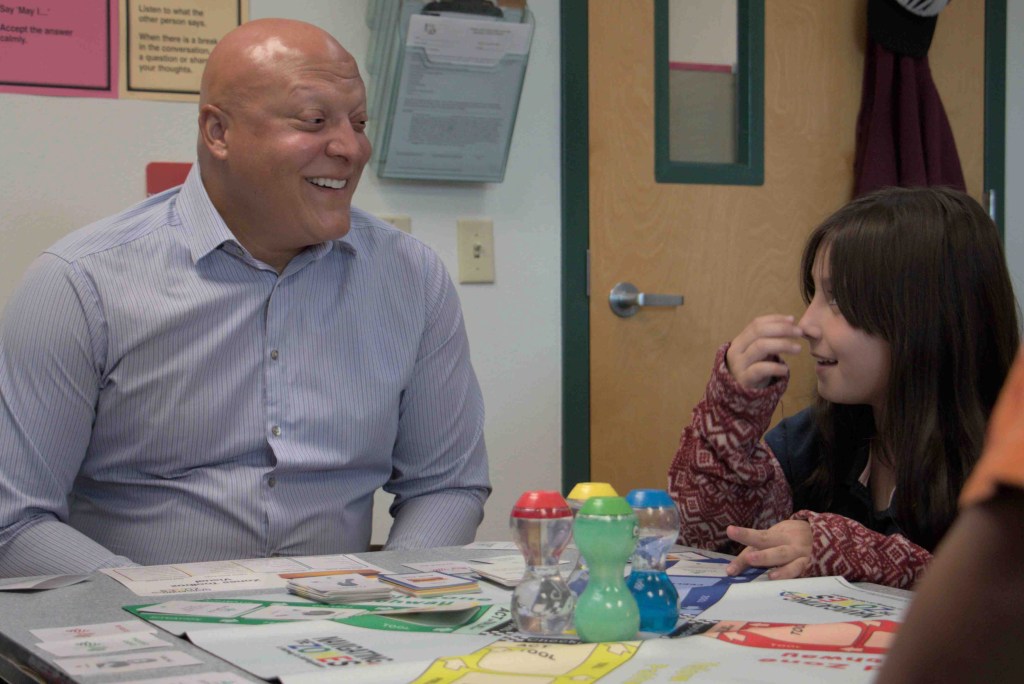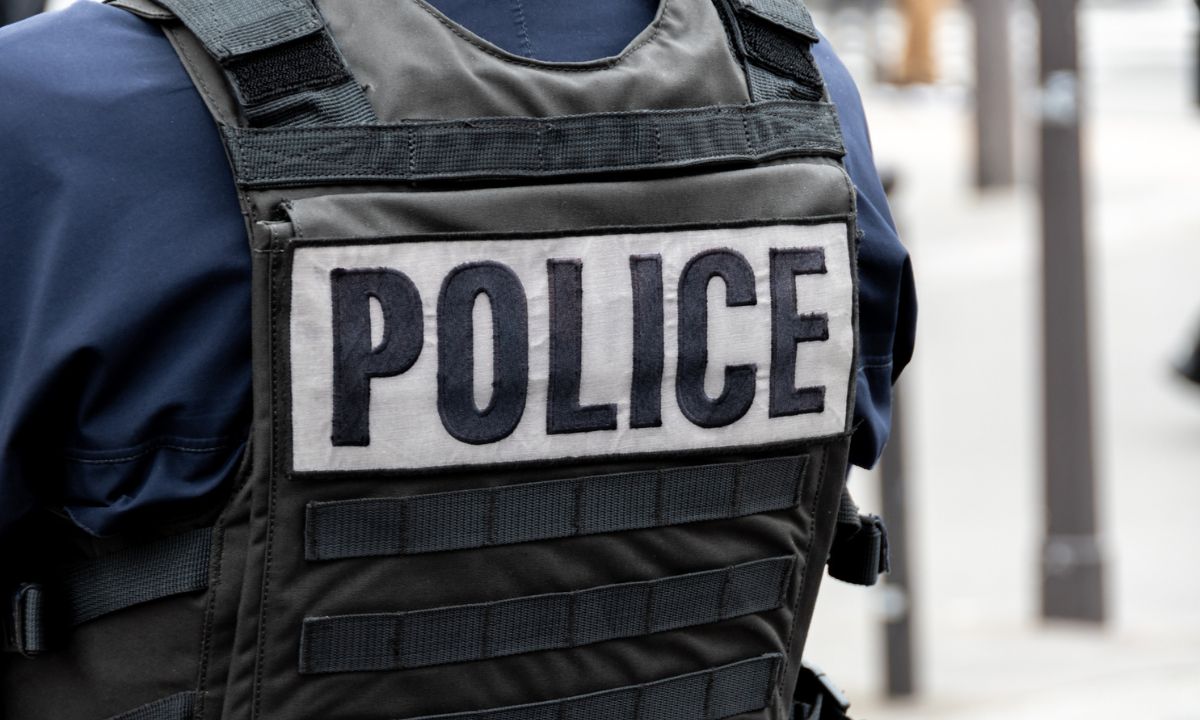Get stories like this delivered straight to your inbox. Sign up for The 74 Newsletter
Brian Miller is a fixture at Charles W. Harris School in Phoenix, a familiar face kids and parents encounter four days a week.
Mornings and afternoons, the school resource officer is in the parking lot directing traffic — and sometimes, he notes, defusing a little road rage. Before lunch, he’s on the playground herding students toward the cafeteria, or in classrooms where teachers have requested help. In between, he’s walking the campus or in his office, on standby for serious disciplinary incidents or lockdowns prompted by crimes nearby.
What he doesn’t do, Miller acknowledges, is provide comprehensive mental health services to the many students who need them. That’s where Cartwright Elementary District’s counselors and psychologists come in.

District officials believe both types of positions are essential for a secure campus, which is why they asked the Arizona School Safety Program to fund one officer and one additional counselor at 19 of their schools, including Harris, this year. In all 19 cases, the state paid for only the officers, the result of a 2022 legislative requirement forcing the Department of Education to prioritize requests for campus police over mental health positions.
In fact, more than 100 schools throughout the state received officer funding while a counselor or social worker request went unfulfilled this year, as Superintendent of Public Instruction Tom Horne embraced the strings Republican lawmakers had tied to the grant money. In another 130 cases, schools that asked only for mental health positions did not receive them, according to an AZCIR analysis of School Safety Program data.
Overall, district and charter schools requested funding for 857 counselor and social workers and 301 campus officers, citing problems with bullying, trauma, suicidal ideation, truancy and more in the hundreds of applications reviewed by AZCIR. About a third, or 291, of those mental health positions went unfunded after the grant program ran out of cash.
The apparent mismatch between what schools need and what certain state leaders want to give them reflects an ongoing clash over which types of positions actually make a campus safer. In the wake of tragedies like the Uvalde, Texas elementary school shooting, proponents of campus police say officers are the professionals best equipped to respond to dangerous situations, while advocates for expanded mental health services argue counselors, social workers and psychologists could help stop many of those situations before they start.
In interviews with AZCIR, officials representing districts and charter schools in both rural and urban areas across Arizona were hesitant to criticize the School Safety Program, worrying they would be perceived as ungrateful for needed funding. But they indicated it should be up to school leaders, not politicians, to determine which positions are best suited to tackle the post-pandemic surge in mental health issues they’re observing among students.
“The schools know better what is needed,” said Monika Fuller, director of Prescott Valley School, a K-9 charter that received money for police but not a counselor this year.
Pointing to the breakdown of funding requests, she said the “numbers don’t lie.”
Arizona leaders expanded the School Safety Program, initially created to fund school resource and juvenile probation officers, to cover counselors and social workers in 2019. At the time, the state had the worst student-to-counselor ratio in the country — 905:1, nearly four times the recommended 250:1 — as schools continued to confront Recession-era cuts that had decimated the ranks of campus-based mental health professionals.
The program, which awards funding on a three-year basis, could not meet the resulting appetite for counselors and social workers, leading to a wait list nearly 90 schools long. That demand only grew after COVID-19 swept the state, leaving students to cope with new sources of grief, anxiety and anger.
In 2021, the state Department of Education dedicated $21 million in federal pandemic relief dollars to unfunded campus counselor and social worker positions. The move eliminated the wait list, which had continued to grow, and further reduced the state’s student-to-counselor ratio to 651:1. But, with the federal dollars’ 2024 expiration date in mind, schools expressed a desire for a more stable, permanent funding source for mental health staffing.
Instead, the GOP-controlled Legislature decided to prop up the School Safety Program for another three-year cycle — and stipulated the additional $50 million had to go toward requests for school police first, before officials could consider counselor and social worker needs.
Though schools could technically apply for up to two School Safety Program positions of either type this year, Horne warned applicants that schools with “no armed presence” would “not receive a recommendation from this Department to the State Board of Education” if they didn’t request an officer. In some cases, this led schools to rank their requests for SROs as higher-priority than their requests for counselors or social workers, in an effort to make sure they got at least something.
Yet campus officers are not interchangeable with school counselors or social workers, even if some of their responsibilities overlap.
“Fundamentally, school resource officers are taking more of an enforcement approach … and often are viewing behaviors through a lens of threat,” said Angela Kimball, senior vice president of advocacy at national mental health policy coalition Inseparable. School mental health professionals, meanwhile, are “viewing behaviors as a manifestation of challenges a youth may be having in terms of their thoughts, their feelings, their perceptions” and “giving them coping skills,” she said.
Fuller, the Prescott Valley School director, is hopeful that whoever fills the charter’s School Safety Program-funded officer position can back up administrators on “heavy-duty” disciplinary issues. But she said the roughly 450-student school, which has been relying on a virtual counselor because it’s “all we can afford,” still needs in-person mental health support — both to provide targeted interventions for kids with emotional disabilities and to help educators address students’ pandemic-related trauma more broadly.
Cottonwood-based Mingus Union High School District, which has just one physical school, is much better off when it comes to campus mental health professionals: Its high school has counselors for each grade level, as well as one psychologist.
But even that team has struggled to fully meet what Superintendent Mike Westcott described as the mounting “needs of the students around social-emotional health,” particularly as the rural school finds itself having to “step up in ways that maybe schools in larger areas don’t.”
Like Prescott Valley, the district sought funding for both officer and counselor positions, with Westcott envisioning the additional counselor working as a liaison with area mental health agencies. The district also hoped a new counselor could help implement suicide prevention efforts, trauma-informed teaching strategies and grief management services, so the state’s decision to grant only the SRO request has left Mingus Union “in a bit of a lurch.”
Westcott also expressed concern over the patchwork of limited-term grants and relief funds districts have largely relied on to pay their mental health professionals, as did several other school officials interviewed by AZCIR. He urged the Legislature to view campus counselors and social workers not as “extras” but as “integral components of what we do,” and to fund them “in a way that can be sustained.”
Uncertainty about the positions’ staying power, as well as shortages of available law enforcement officers and mental health providers, has made it difficult for some schools to hire at all. As of October, more than 130 School Safety Program-funded SRO posts remained open, according to ADE, as did 148 counselor and social worker spots.
That month, the state’s School Safety Task Force unveiled a plan to fill campus police vacancies by shifting more than $18 million in grant funding for full-time SROs to part-time school safety officers. It offered no comparable plan to assist schools with counselor and social worker vacancies.
After the task force presented its final report on Dec. 7, Horne doubled down on his commitment to the police-first approach, saying he had “very little patience” for criticism.
“I’ve encountered opposition from people who say they don’t want a school-to-prison pipeline,” Horne said, referring to those who’ve questioned whether boosting the ranks of campus officers would ultimately push already-marginalized students out of the classroom and into the criminal justice system. “What they’re really saying is people should be able to violate the law without consequence.”
Under the part-time officer staffing plan, off-duty police sign up to work school safety shifts as their schedules allow, a change that has reduced vacancies but sacrificed the kind of continuity districts like Cartwright believe have made their officers successful.
Ema Jáuregui, the deputy superintendent who oversees the district’s SROs, said officers’ ability to have a consistent, visible presence at a specific school has been an essential part of building trust and goodwill with students and families in the Maryvale area.
“Our community, they value the SROs because they see them out on the playground. They see them out during (pickup and dropoff) traffic. They see them talking to kids in a positive way,” she said. “When Uvalde happened, you would not believe how many kids did not want to come to school because they were scared, and I think the police presence made our families and kids feel safer.”
Jáuregui acknowledged not every school system has had the same experience, calling Cartwright “very lucky.” Nationwide, school resource officers have made headlines for using excessive force against children, disproportionately arresting students of color and for contributing to what civil rights organizations have described as a threatening, rather than safe, school environment.
Arizona School Safety Director Michael Kurtenbach has repeatedly emphasized the importance of officer training when it comes to preventing such controversies. Kimball, the national mental health policy advocate, said she has seen training in adverse childhood experiences and trauma-informed care help school police shift their focus from rigid enforcement to understanding and prevention elsewhere in the country.

Still, she believes it’s better to hire mental health professionals directly, versus “hiring people that you have to train to be like mental health professionals.”
Harris School Resource Officer Miller, for his part, promotes a collaborative approach that involves school police and mental health staff working closely while deferring to each other’s areas of expertise.
To make the arrangement work, he said, police must adopt “a different mentality” when shifting from patrol work to a campus setting — and not every officer can do it.
“You don’t talk to people (at a school) the same way you do on the beat. It’s a different philosophy,” he told AZCIR. “And if you don’t have that desire to work with kids, this is probably not the position for you.”
AZCIR is part of the Mental Health Parity Collaborative, a group of newsrooms that are covering stories on mental health care access and inequities in the U.S. The national partnership includes The Carter Center and newsrooms in select states throughout the nation.
Get stories like these delivered straight to your inbox. Sign up for The 74 Newsletter


;)